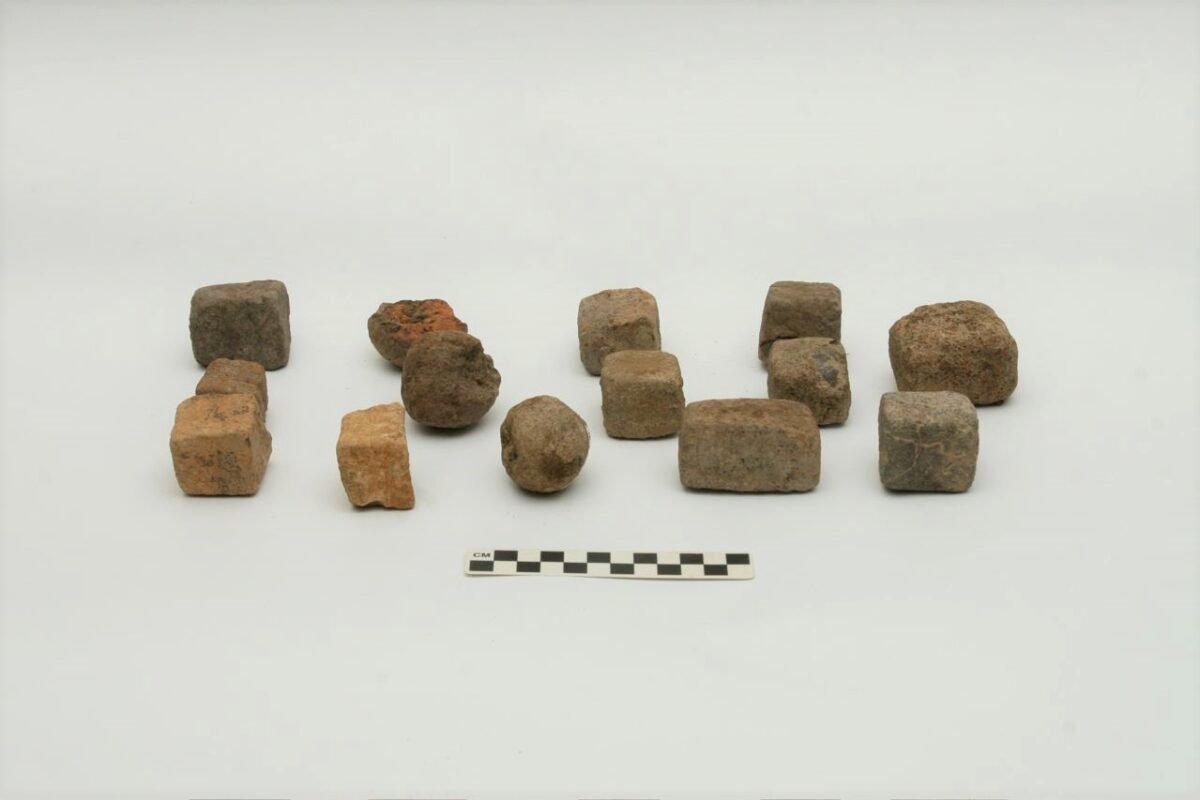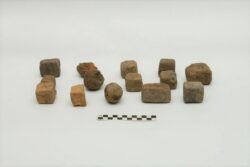Evans Culture
This entry covers the prehistoric Evans culture during the Middle Archaic Period, 6000–2000 BCE.

Photo by Joe Saunders
Fired earthen blocks, possibly used in cooking, recovered from an Evans culture site.
Until recently, cultures in the Middle Archaic period were viewed as little different from Early Archaic cultures. However, this attitude overlooked the importance of environmental change and the availability of new resources. By 6000 BCE, sea level had risen high enough to slow the flow of the Mississippi and other rivers. Slower currents helped create the meanders, loops, and oxbow lakes so characteristic of southern rivers today, and also allowed for the development of estuaries. People began to focus on riverine and estuarine plants and animals for most of their subsistence needs. While hunting was still important, fishing provided the most nutrients and calories. In some areas, shell fishing also became a mainstay. These resources have played a key role in the diets of Louisianans from the Middle Archaic to the present.
The abundance and predictability of these resources may have played a significant role in supporting another development of the Middle Archaic—the construction of earthen mounds. Currently, the oldest of these mound sites is the Monte Sano site, in East Baton Rouge Parish. Mound A at this site has been dated to earlier than 5000 BCE; artifacts recovered from the mound suggest ties with the Benton culture of the lower Midsouth. The “Evans culture” (3400–2800) is the archaeological term for the people who built the first known mounds in northeast Louisiana. Other Middle Archaic cultures remain poorly defined and are not named. This includes the culture that built the Louisiana State University Campus Mounds, which date to circa 4000 BCE. In all, there are thirteen well-dated Middle Archaic mound sites in Louisiana, but there are undoubtedly more, just waiting for more exploration and better dating.
Middle Archaic Cultures: Definitions and Important Sites
Our understanding of Middle Archaic cultures has emerged from a mixture of information from residential camps and mound sites. One of the residential sites is the remarkably well-preserved Conly site, which has provided the first extensive information on Middle Archaic life at a domestic site. Mound sites like Watson Brake provide information on daily and ceremonial life.
The Conly site is in Bienville Parish, along Loggy Bayou, a tributary of the Red River. The site was buried under nearly ten feet of Red River flood deposits, but several excavations were conducted at the site as portions of it became exposed along the riverbank by erosion. The information provided by the Conly site is so important to understanding cultures at this time that the site has been placed on the National Register of Historic Places. To prevent further erosion, the site has been covered with rock.
Radiocarbon dates suggest that the Conly site was used for a few centuries sometime between 6200 and 5400 BCE. Conly is virtually the only site in Louisiana with good faunal and floral preservation that dates to this period. Results from excavations at Conly provide details on artifacts in daily use and on plant and animal foods eaten. The animal bones also provide information on what time of year the animals died, and by extension, the seasons of the year that the site was occupied.
Excavations also revealed at least one large cooking hearth, along with large storage pits. Smaller pits or postholes may represent the remains of shelters or other structures. In addition, the burials of three adults and a child, as well as a small bone from an unborn infant, were unearthed. Domesticated dogs were buried as well.
The pits, postholes, and burials point to a significant investment in the site, which generally indicates that people lived at a site for some time. The Conly site may be an early residential camp, where people lived for a large portion of the year but made routine visits to other locations for specific resources. Information from fish otoliths (ear bones), which record seasons in a manner similar to tree rings, along with other seasonal indicators (e.g., migratory waterfowl bones), also suggest the site was used in all four seasons.
Middle Archaic Mounds
Until recently, most archaeologists did not even entertain the idea that mounds were built in the Middle Archaic period. But that was before Louisiana archaeologists made a concerted effort to obtain radiocarbon dates from mounds that were suspected to date to the subsequent Late Archaic period (2800–800 BCE). To almost everyone’s surprise, a number of sites were found to be even older. Currently, there are thirteen sites in Louisiana that date to between 5000 and 2800 BCE, during the Middle Archaic period. Many archaeologists believe that one of the functions of these mounds was to mark a central place where scattered groups gathered at certain times of the year for ritual and social events.
The controversy over early mounds resulted from preconceptions about what kinds of cultures could build such monumental features. According to the model that prevailed prior to 1990, Archaic-period, egalitarian hunters and gatherers could not have built mounds. Scholars thought mound building required someone with hereditary power to command labor, someone like a chief. In addition, archaeologists believed that mounds could not have been built by hunting and gathering peoples—that only agriculture could provide the stable, predictable, and abundant food supply necessary to divert labor from subsistence activities to “wasteful” pursuits like mound building. But these mound builders did have a stable, predictable, and abundant food supply in the bayous, lakes, bays, and estuaries that had formed by this time.
The Evans Culture
By the early 1990s, there were enough mound sites with Middle Archaic–age radiocarbon dates that the old model collapsed. Instrumental in the collapse were six mound sites in northeast Louisiana that yielded good radiocarbon dates, firm geological support for the antiquity of the mounds, and a distinctive suite of artifacts that distinguish this culture—which archaeologists have called the Evans culture—from other Middle Archaic societies. With respect to the earlier model of mound builders, it is important to emphasize that there is no evidence of any kind of social hierarchy or plant cultivation at Evans culture mound sites.
The most famous Evans culture mound site is Watson Brake, a complex habitation and mound site containing eleven mounds connected by earthworks that surround a plaza. The other five sites have less than seven mounds. The layouts of all six sites appear quite different, suggesting little collaboration between communities in site construction, and perhaps little interaction between communities at all. However, some researchers see a subtle but persistent commonality in the geometric relationship of the mounds with one another, and the six sites do contain the same unusual set of artifacts, which argues for considerable interaction.
Evans Culture Artifacts
The Evans culture was named after a distinctive spear point called the Evans point, which dates to 3400–2800 BCE. Many projectile points produced before and after the Middle Archaic period have a pronounced stem that helped to secure the point to the spear. The stem was created by making notches (indentations) in the base or the side of a point. The creators of the Evans point went a step further and added an additional notch on each side of the blade. The less common Sinner point has two or three additional notches. The Evans culture is also known for producing small blocks of fired earth. The shape of these blocks is so unusual that their function is unclear. They may have been used like the more common, Late Archaic Poverty Point objects, which were heated and then placed in pits to bake food or to heat rock to improve its workability. People stopped making both the Evans and Sinner points and the blocks at about the same time that mound construction ceased. Other stone artifacts found at Evans culture sites are not unique to the culture. These include celts (used for chopping) and more conventional stemmed points.
Daily Lives and Deaths
Archaeologists conclude that Middle Archaic period societies were composed of small, egalitarian bands, perhaps centered at residential camps like Conly and, to a lesser extent, at mound sites like Watson Brake. Both of these sites have a number of smaller sites nearby. The smaller sites have fewer artifacts, and are probably short-term encampments where specific activities, such as gathering a particular food, took place.
Conly and Watson Brake provide information on what foods were eaten and what kinds of tools were used to capture and prepare foods. Bone preservation at both sites was excellent in some areas, due to the alluvium at Conly, and to the presence of mussel shell (which lowered soil acidity) at the base of Mound B at Watson Brake. Fish, including catfish, freshwater drum, and sunfish, were very important parts of the diet, providing as much as 80 percent of the meat eaten. Deer, small mammals such as rabbit, squirrel, and raccoon, along with turtles and freshwater shellfish (mussels and snails) were also important parts of the diet. In addition, acorn and hickory nuts and grape, sugarberry, goosefoot, and marsh elder were gathered. With minor modifications based on site location, this basic diet continued in Louisiana until at least 1200 CE.
The most common artifacts at Conly and Watson Brake were used for cooking. Abundant fire-cracked rock indicates that hot rocks were used to roast and steam foods and may have been used in stone boiling. (Clay pots were not commonly used in Louisiana until circa 800 BCE). Other stone artifacts were rare at Conly, but bone tools were common. Stone tools were more abundant at Watson Brake, where the majority of the tools were tiny finished and unfinished drills. These were probably used for creating holes in stone beads. Curiously, archaeologists found 154 drills and 93 unfinished drills, but only seven beads were found and only three of these were completed to the point that they were drilled. One wonders where all the finished beads have gone.
There is no evidence for human burials in Evans culture mounds. This is consistent with the idea that Evans culture peoples were egalitarian. The admittedly limited evidence from Conly suggests that individuals were buried at residential camps soon after death. No mortuary items were found with the Conly burials, which again suggests an egalitarian ethos.
Final Thoughts
The Evans culture, with its distinctively notched points, odd earthen blocks, and enigmatic mound sites, disappeared after 2800 BCE. No mounds were built in Louisiana or elsewhere in the Lower Mississippi River Valley for more than a thousand years. The cessation of mound building correlates with, but may not have been caused by, a particularly severe El Niño–Southern Oscillation event that lasted from 2975–2675 BCE. This event created severe and persistent flooding in the Lower Mississippi River Valley, with calamitous floods occurring every few years. Habitation in the valley continued, but, for a millennium, ceremonial life did not include either mound building or the use of earlier mounds.
